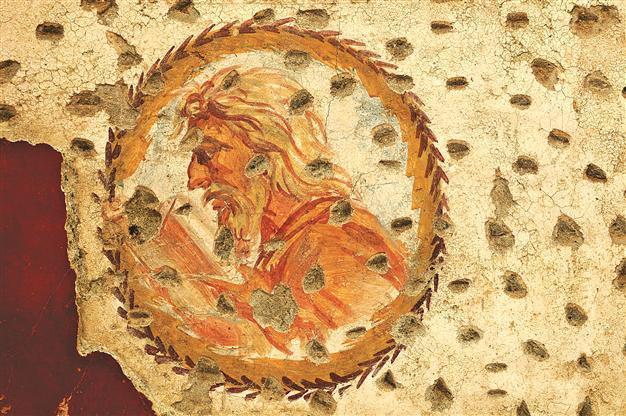Yamaç Houses of Ephesus reveal mysteries of history
IZMIR - Anadolu Agency

The project in Ephesus, which started in 2012, aims to protect and preserve the Yamaç Houses, which contains important wall drawings. AA photo
The restoration and protection of two Yamaç Houses (Terrace Houses) and two settlement areas out of seven have been completed, said Ephesus excavation president Dr. Sabine Ladstaetter. The excavation and restoration works in Ephesus, where signs of inhabitants go back to 6000 B.C., uncovered a structure near the ancient theater as archaeological works there entered their 111th year.The ancient city was home to numerous magnificent structures, such as those in the region called Yamaç Evler, dwellings thought to have been inhabited by wealthy families.
Ladstaetter said the Yamaç Houses of Ephesus were built in a very luxurious way, at a press conference to make the completion of the restoration. While carrying out the excavations, the team has kept and protected the wall drawings, she added.
The project, started in 2012, aims to protect and preserve the newly-founded Yamaç Houses of Ephesus. “Among seven Yamaç houses two of them have been restored,” said Ladstaetter, and added that these restorations were highly significant.
Ladstaetter said there were a total of 78 rooms and different wall drawings in the houses. Among those wall drawings, eight have been resorted. The wall drawings are very important, according to Ladstaetter. “These wall drawings start form the first century and continue to the third century. We can see them in one room,” she said. In some of the rooms there were up to five drawings that had been drawn on each other at different times.
Financial support
Ephesus association general manager Gülsevim Avcı Tolunay said that in 2013 they had supported the restoration of wall drawings in three of the rooms.
Noting that it was impossible to carry out these works without sponsors, Avcı Tolunay said the only way to finish this project was to support the project with financial means. “Things like this request a long time and money. One room’s budgets are 40,000 euros. The three rooms’ restoration is 120,000 euros and this year the total budget for the rooms was 230,000 euros,” she added.
“We need sponsors,” she said, noting that the aim was to reveal the cultural heritage.
Kurtuluş Türk, who is involved with the restoration works, said the drawings were made with natural paint. “In each room there are different paintings and these paintings have different characteristics, such as the Eros room, birds room, human and plants room.”
Ephesus is one of the places that attract the largest income, in terms of cultural sites of interest. The Ephesus ancient city was one that brought the highest income to the province. Its visitors paid about 9.34 million Turkish Liras throughout the year. As a result, the income of the museums and ancient sites affiliated with the İzmir Cultural and Provincial Directorate, which was around 12.28 million in 2011, increased to 13.83 in 2012 with an increase of 12.7 percent.
The largest income in 2011 came from the ancient city of Ephesus. The income from this ancient site was over 8 million liras, data showed. The number of visitors increased by 12.9 percent compared to the previous year, and 2,082,834 people visited the ancient city.
Ephesus was followed by Yamaç Evleri in the district of Selçuk, with earnings of 1.26 million liras and the Acropolis in Bergama with 1.05 million liras, according to the data.

















